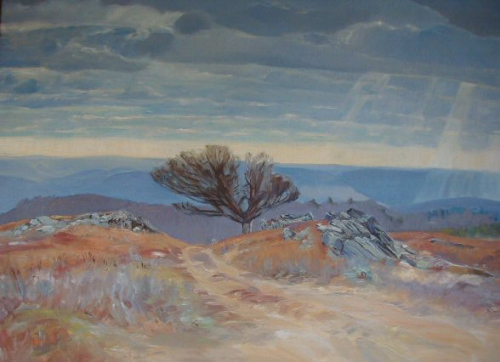Heath Pasture Studio
and the Beech Tree
The Pasture House Studio
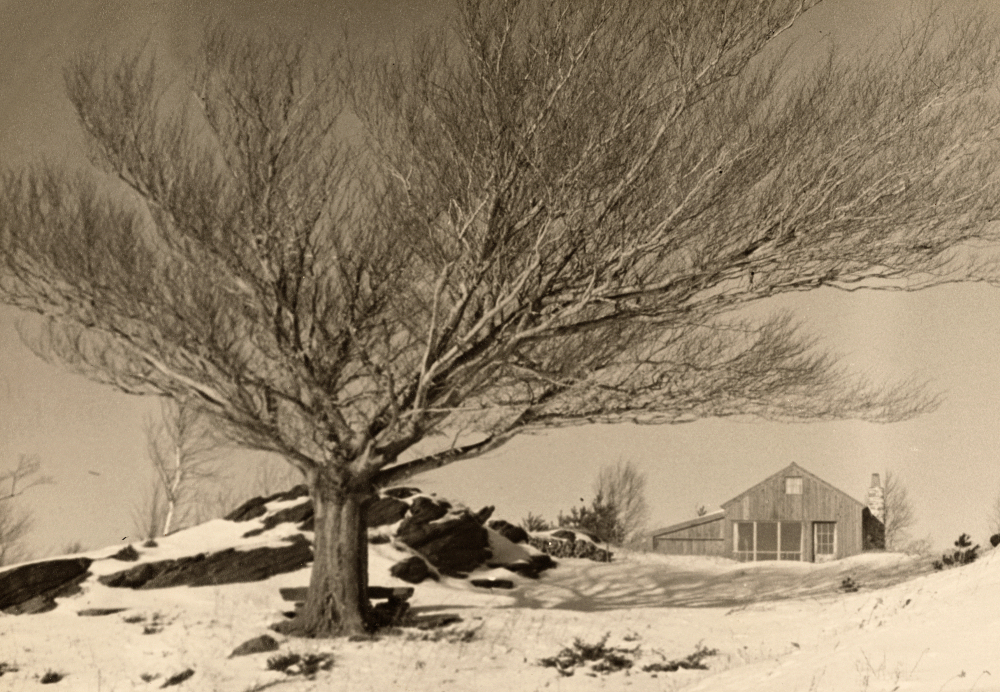
The Heath Pasture Studio and Beech Tree on Burnt Hill. Photo by Burt Ashworth.
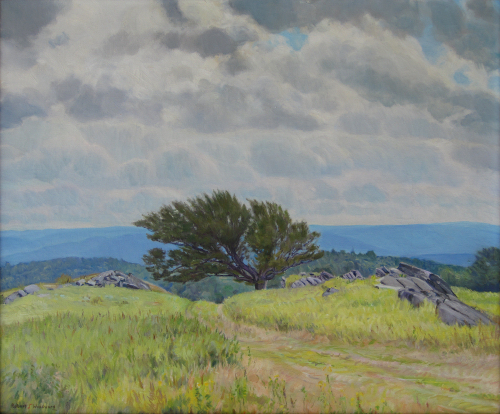
The Beech Tree an oil painting by Robert Strong Woodward.
He made many paintings here and eventually exchanged two oil paintings (Blue Drifts and Autumn Brilliance) with the owners for the abandoned 140 acres of mountain top pasture land. The original owners of this mountain top property were Roswell and Florence Tripp then of Rye, New York and Heath, Mass. Their summer home in Heath had been burned to the ground by antique thieves and the mountain pasture had little use to them.
On this land, RSW's hired man, Fabian Stone, built a rustic studio called the Pasture House Studio so that he would be able to continue to paint even on cold winter days. In those days it was not a town-maintained road out to the property. Hired help had to keep the road open except in midwinter and in the worst of "mud season."
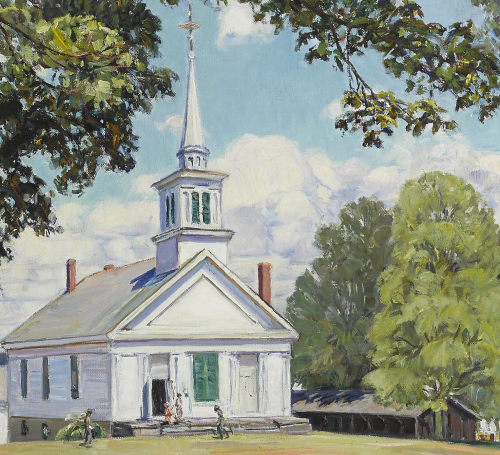
A closeup of Mary Lyon's Church showing the horse shed to the right.
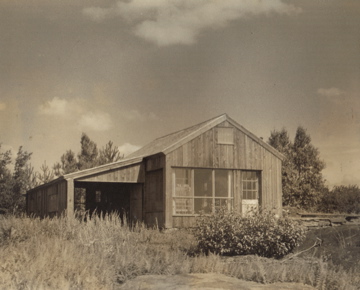
RSW looking out the window of the Heath Pasture Studio.
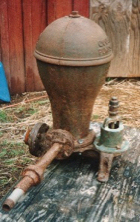
A water ram pump.
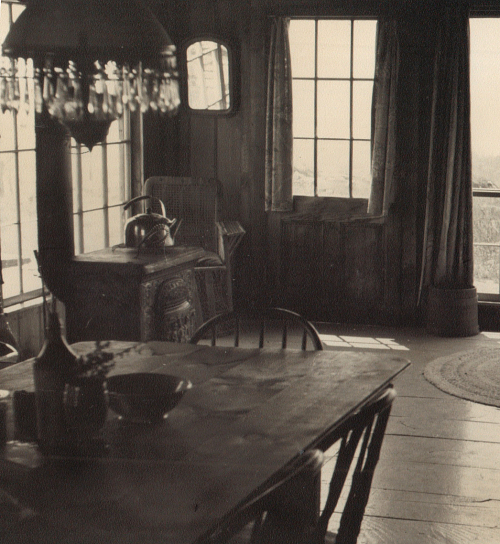
A photograph of the Heath Pasture Studio showing the wood stove,
hanging oil lamp, braided rug, mirror and table. Photo by F. Earl Williams.
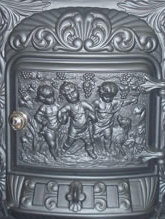
Cherubs on similar stove.
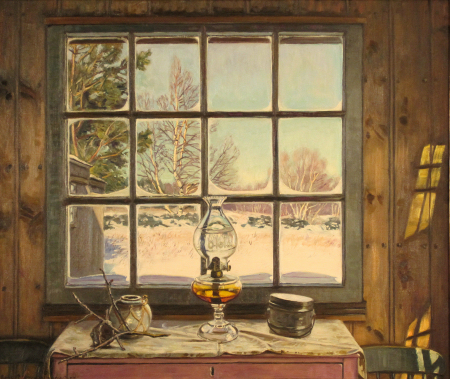
The painting Frost on the Window shows an oil lamp, the purple
bureau, and the rear view out the windows of the Heath Pasture Studio.
There were several hand braided rugs on the floor, a comfortable couch to lie down on, several stiff New England straight back chairs, a dining table in the center of the room, an old--fashioned mirror, a kerosene ceiling hung lamp and a handsome purple bureau beneath the rear window.
Of course, there was no electricity. All the lighting at night came from oil lamps and candles.
A writer for the Worcester Mass Telegram on June 28, 1942, submitted the following description of a visit to the Woodward Southwick Studio and a trip up to the Heath Pasture House Studio.
Webster's Dictionary:
"Shangri-La: imaginary land depicted in the novel Lost Horizon by James Hilton. A remote beautiful imaginary place where life approaches perfection: Utopia. A remote usually idyllic hideaway."
Modern Shangri-La
LOOKING OUT over the far hills of Northern Massachusetts and the deep valleys of Buckland (near Shelburne Falls) from the tea terrace of Robert Strong Woodward, artist who has immortalized this scene and has thrown over every corner of his own domain a mantle of spiritual and material beauty, came the lovely illusion of the picture version of "The Lost Horizon." The same tranquility and peace, the same vast pattern of the universe seemed to brood over those distant hills. The man who looks out over the valley and lives in the harmony of his own New England home, with easel and paint brushes where once a blacksmith toiled, is the spirit of all this, transcending mere time or space. Later when the distant hills were shut out and the studio curtains drawn close, the color he has give to his canvases glowed for his guests.Until last week-end the reproduction was enough. Now his chalk drawings and oil paintings haunt me with remembered loveliness. One great New England tree, this native beech, dominates much of his work. The following day, Sunday, continued the pilgrimage in his own beach wagon to the top of Burnt Hill, and his Heath Studio there, approachable through drifting snow as late as February every year. This magnificent tree, seen through the window in the photograph (made by a Woodward admirer and friend, Principal Williams of the Gardner High school), reaches the height of five feet before the branches begin. It is windswept. This goes unsaid in such a location. It has a fair background of ever changing valley and mountain, a panorama shut out by rain and cloud one week ago today. It was just as well. The travelers had enough to remember without that further glimpse of infinity!
Inside the Heath Studio was homely comfort of stove and braided mat, cupboards with hand-hewn pegs. Chairs that look as stiff as the New Englanders who fashioned them, and belie their looks as much as their human prototypes, were enjoyed for the brief hour on the summit. Descent into the valley again, brought a startled deer bounding across the path, the last fantastic analogy with the dream world of Shangri-La. A studio dinner with literal "pot luck" of stew, salad, watermelon and fragrant coffee sent the travelers on their reluctant way back home to reality. Glimpse of a rare beauty of soul, and genius of artistic creation, a house where in every vista within and without brought exquisite harmony of color, form and expression of gracious living, was ours to reflect on along the way.
Worcester Telegram, June 28, 1942
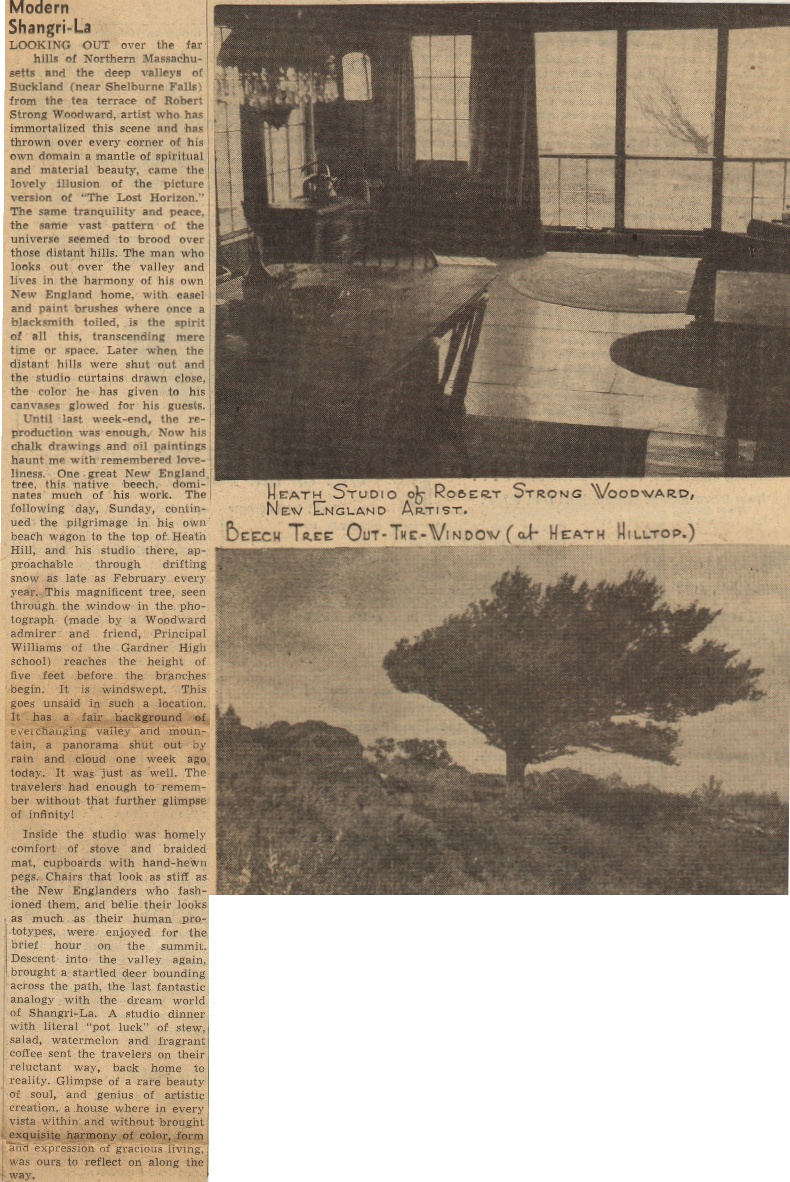
Shangri-La indeed:
To Robert Strong Woodward, the Heath Pasture Studio was indeed Shangri-La.
It was a place where he could get away from (in his words) "the constant hustle and bustle of nurses, housekeepers, hired men and the stresses of the valley life." He could come here and completely relax and forget the invalid life he had to lead down below. It was also a place where he loved to come to sunbathe. He was an ardent lover of the sun. He felt that it had some sort of power to heal and strengthen his invalid body. Many hours were spent, stripped of his clothes, sitting out on the stone patio of the Pasture Studio, soaking up the sun. He also encouraged those who worked for him to follow in his footsteps and strip down to get the sun on their bodies. Even down in the valley he preferred to have his men work shirtless in shorts so that they could absorb the sun into their systems while working on the lawns. So little was known, back in those days, about the harmful effects of sun radiation and it being the cause of various skin cancers.
THE JITNEY
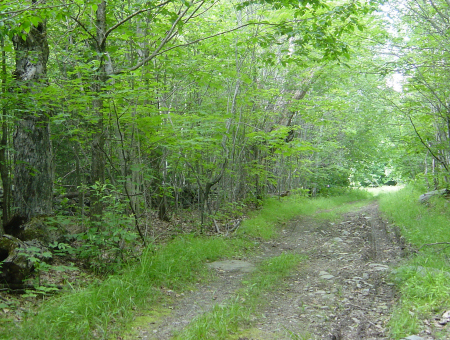
Old road to the Heath Pasture (2006).
AN EXCERPT FROM ALASTAIR MAITLAND essay:
Robert Strong Woodward in The Book of Heath:
"Moreover, although Woodward's Studio no longer stands, enough of it is left to provide us with a precious, if tenuous, physical
link with the artist and his work. The site is still clearly recognizable by the large slabs of ledge rock that once formed the paving
stones of the terrace to the west. Beyond them, scattered over the remains of the foundation, lies the debris of the brick chimney
that had buttressed the south side; and, amongst the fragments of brick and mortar, lumps of molten glass--a poignant reminder
of the perfectionism that was 'Woodward's hallmark.' In all of his studios he insisted on 'old glass' for the windows. Gone too,
alas, and virtually without trace, is the focal point of the
A View From Burnt Hill and of the many other landscapes that Woodward
painted, in all seasons, as he sat on the terrace - the great wind-swept beech that stood some fifty yards below the studio on the
western slope. At the base of the beech Woodward had placed what was in effect a wide stone bench. The bench is still in place.
But there is no shade there now on a summer afternoon. Only the blackened and jagged stump of the once majestic tree remains."
THE BEECH TREE
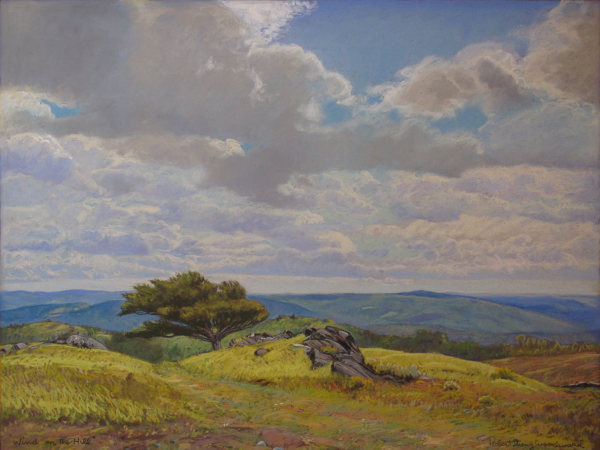
Wind on the Hill an chalk drawing by Robert Strong Woodward.
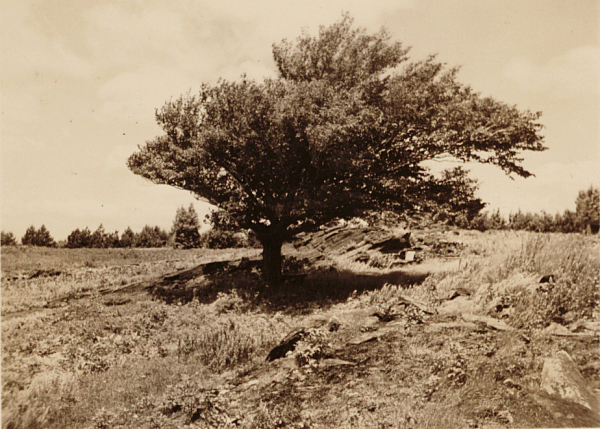
The wind swept beech tree on Burnt Hill - Photo by Burt Ashworth.
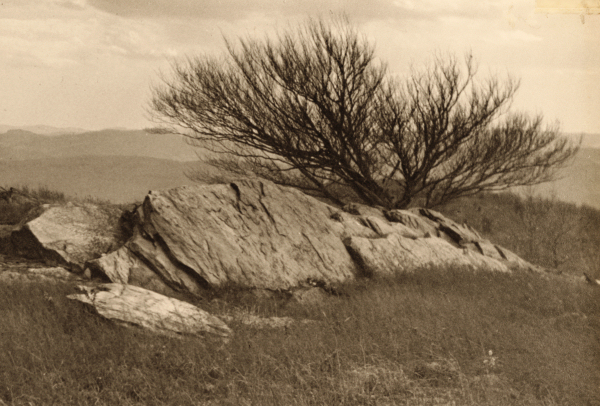
The Beech tree behind the bedrock at the top of Burnt Hill.
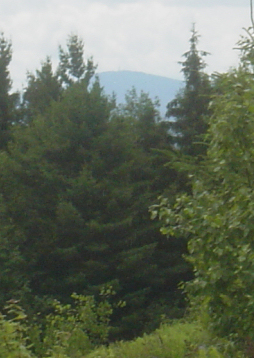
Mt. Greylock as seen from Burnt Hill.
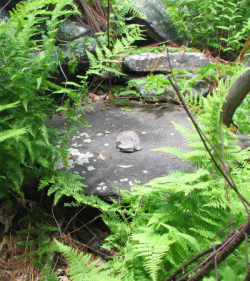
The stone fireplace near the Beech Tree
still seen under the overgrowth today.
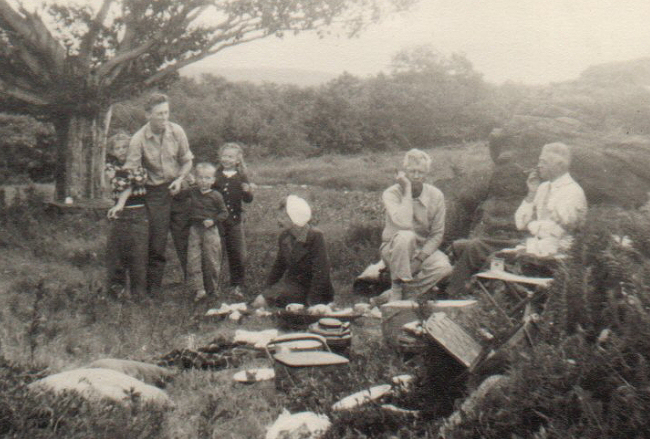
Mark Purinton, the Bauerleins, and Robert Strong Woodward having a picnic under the
beech tree in the Heath blueberry pasture..
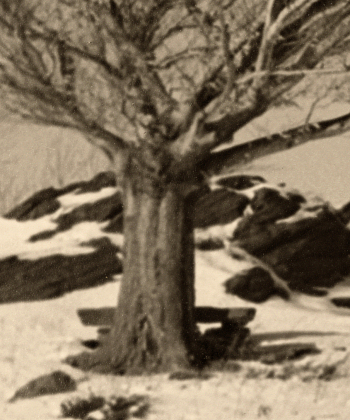
The stone bench beneath the Beech Tree.
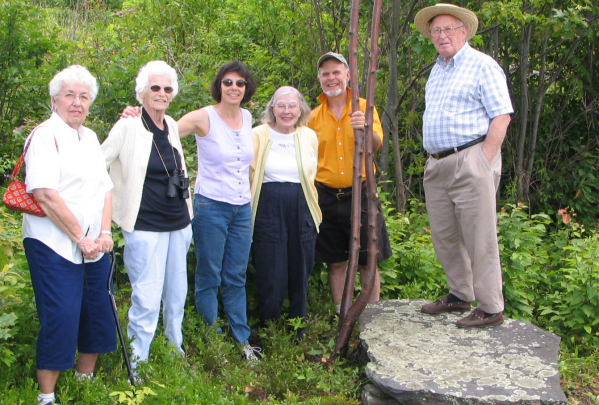
Abbie Labelle, Eddie Gerry, Janet Gerry Nelke, Barbara Purinton,
David Gott, and Mark Purinton standing on the stone bench.
It is the feeling and intent of this writer that this splendorous production of hill top botanic life formed by the prevailing westerly winds of New England should now and henceforth be referred to as THE BEECH TREE....in caps!!
The Blueberry Field
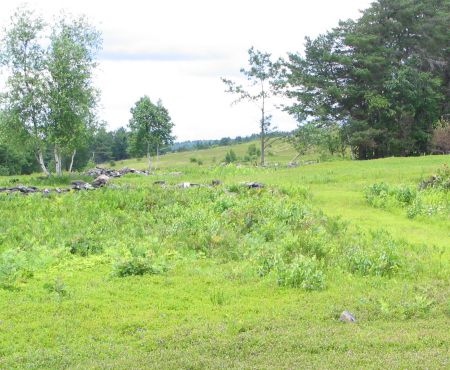
Low bush blueberries on the Burnt Hill pasture.
Burnt Hill is well known, far and wide, for blueberries: wild low-bush blueberries. The history of Burnt Hill dates back to the days of the American Indian. They are said to have cultivated the berries here since prehistoric days. And they even knew how to foster their growth: burning off the fields every fall. The burning not only kept the brush down but the ashes fertilized the earth. The blueberries loved it.

Low bush blueberries.
During the days when Robert Strong Woodward owned the Heath Pasture he continued to enhance the growth of the wild blueberries. During summer months we who worked for him spent many hours cutting the brush which aggressively sprung up over the entire area. A few seasons, before burning restrictions became so restrictive, we even set fire to portions of the pasture to mimic the Indians who had come before us.
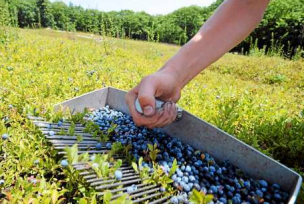
A hand tool for picking low-bush blueberries.
And what do you think they had for dessert? Blueberries, of course!
The Prehistoric site
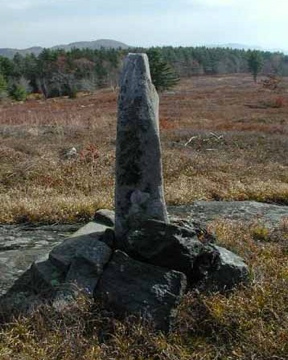
A stone obelisk on Burnt Hill.
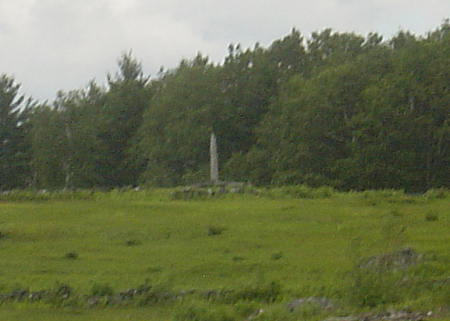
A standing stone obelisk at the Heath Pasture on Burnt Hill.
Click HERE to read the story by an inquisitive young man, Faux Doe, who visited Burnt Hill with the intent of learning about all of the rock formations he had heard about.
Click HERE to read an essay by a geologist, Daniel Boudilion, who also made a visit to the area and made detailed recordings of his findings.
Artist's Heath Studio Burns
HEATH---For the third time in less than three decades Buckland Artist Robert Strong Woodward's studio has been destroyed by fire. At his Burnt Hill here yesterday, Woodward discovered the building burned to the ground sometime since he visited it Saturday.Estimate of the damage was not available today. Only a stone chimney was standing.
Although this was not the artist's main studio, it was a favorite. From its large picture window he was able to look across the sweeping Deerfield valley, which he copied in many mediums during the years. Among the articles destroyed in the fire was a completed chalk drawing of a large beech tree the artist often painted.
On Christmas eve 1922 a studio on the Bert Wells property in Buckland was destroyed by fire and in 1935 a studio on Buckland Road was gutted by fire. The studio here was constructed about then years ago.
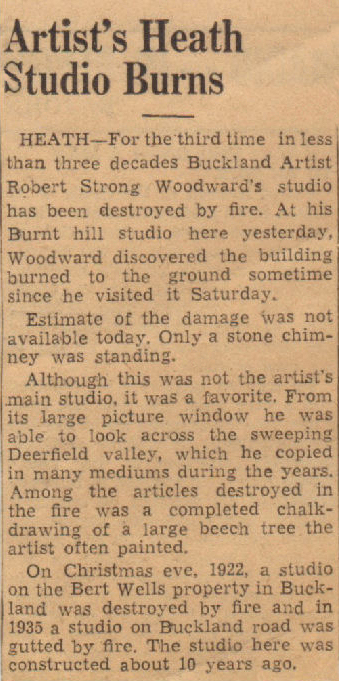
1950
MLP
2014
The black and white photographs below were taken by F. Earl Williams at the Heath Pasture Studio.
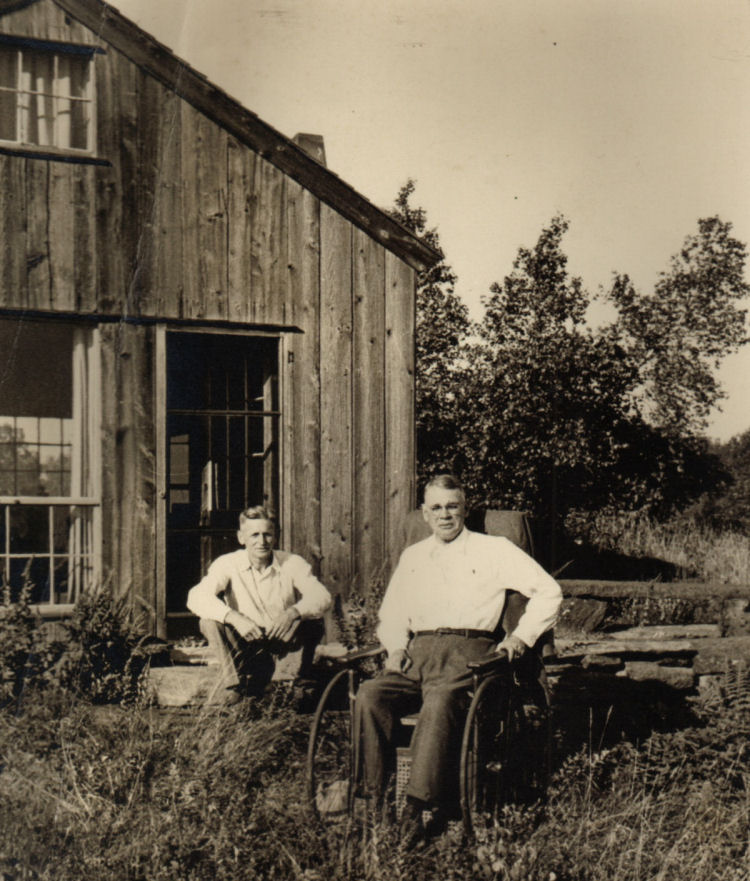
Robert Strong Woodward and F. Earl Williams in front of the Heath Pasture house.
(F. Earl took this with a delayed shutter on his camera.)
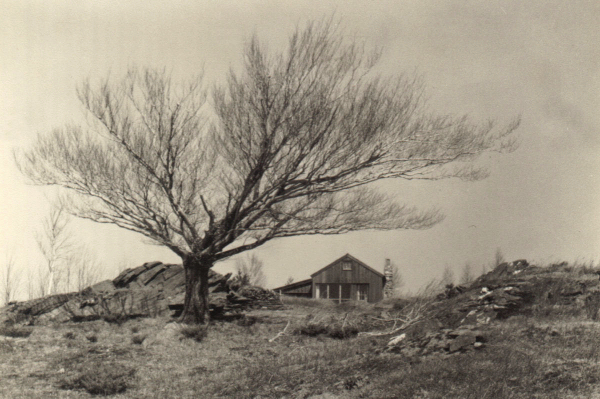
The famous beech tree with the Pasture Studio on the mountain top beyond
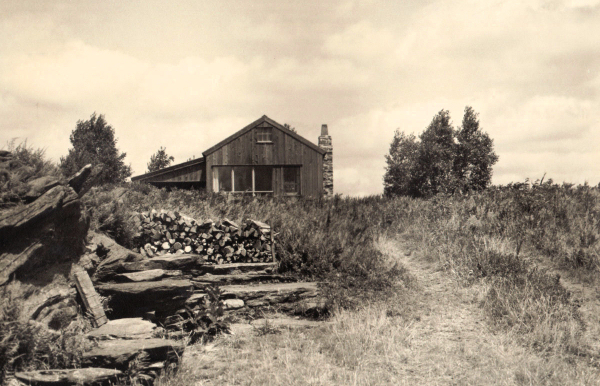
The Pasture Studio above the fireplace where many cook-outs were held. All the rocks
to build it and the surrounding seating were constructed out of slabs of the protruding ledge.
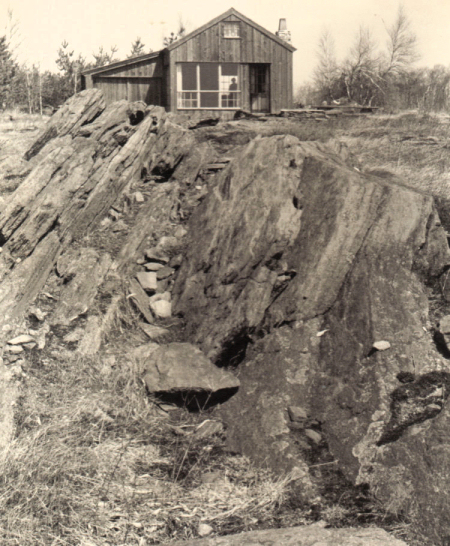
The Pasture Studio over the rocky ledge.
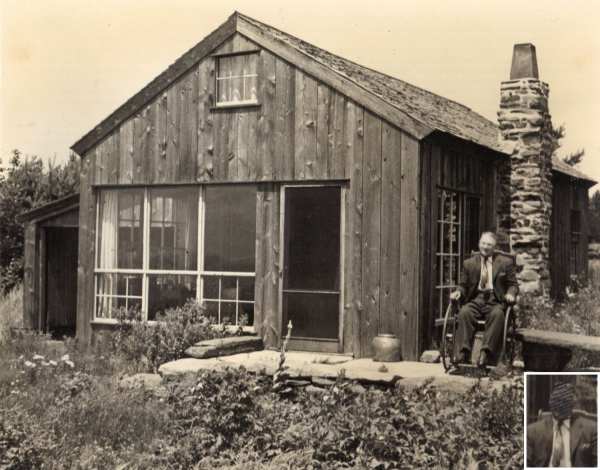
Robert Strong Woodward on the stone steps in front of the Heath Pasture Studio.
Note: RSW did not like to have his photograph taken. On the actual print shown above,
RSW had taken a pen and obscured his face. Another copy of the same print was found
in the collection that F. Earl Williams donated to the Smithsonian museum.
In general, that version of the photograph was not very good, but the image included RSW's
face, so that copy was used to restore the face on the photograph. (see inset).
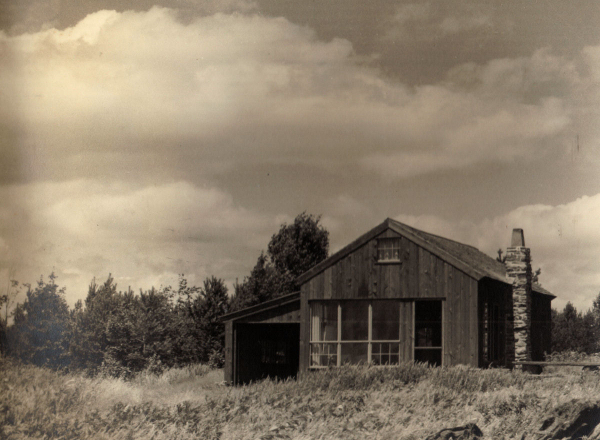
The Pasture Studio with the open garage to left.
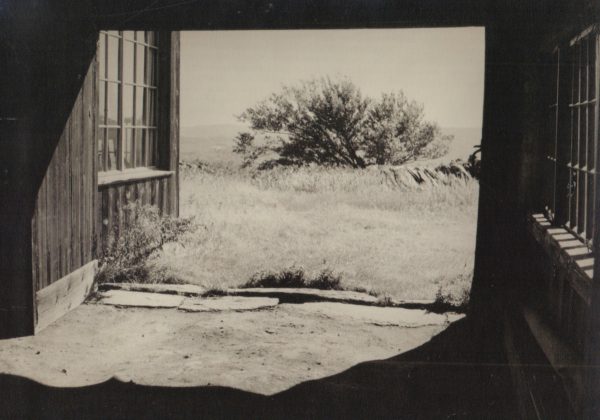
Interior of garage looking towards beech tree similar to the paintings
Invitation and Open Doors.
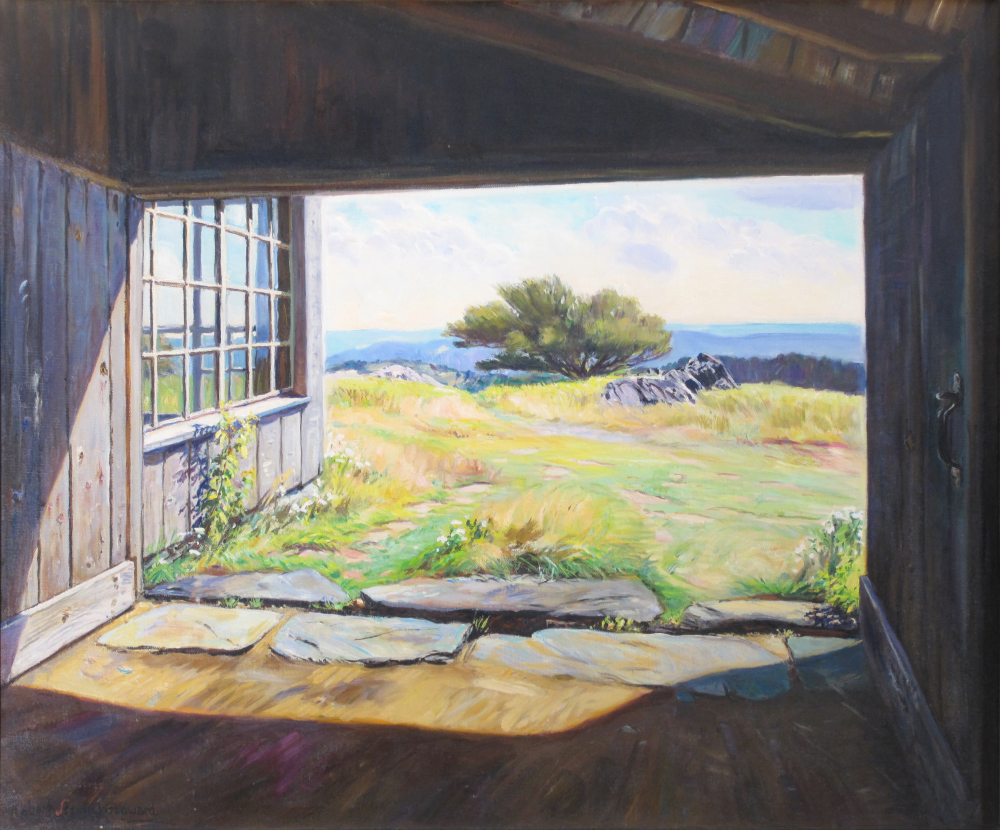
The oil painting Invitation
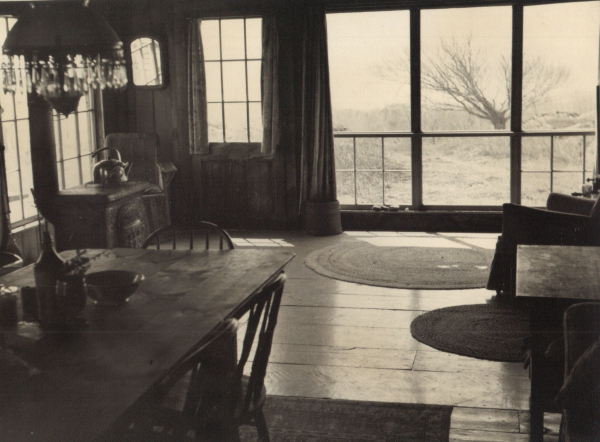
Interior of the Heath Pasture Studio showing tables, chairs and wood stove.
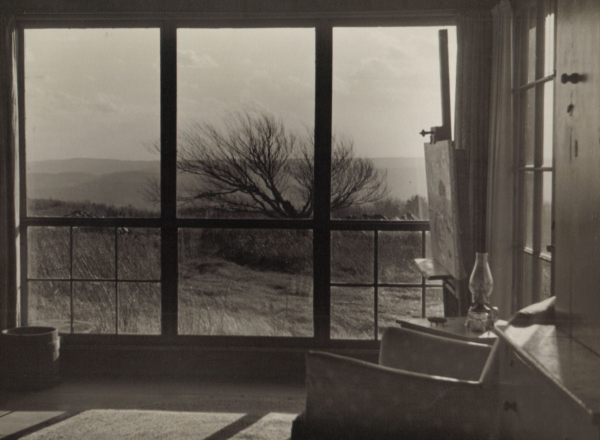
Interior of the Heath Pasture Studio looking out towards the beech tree.
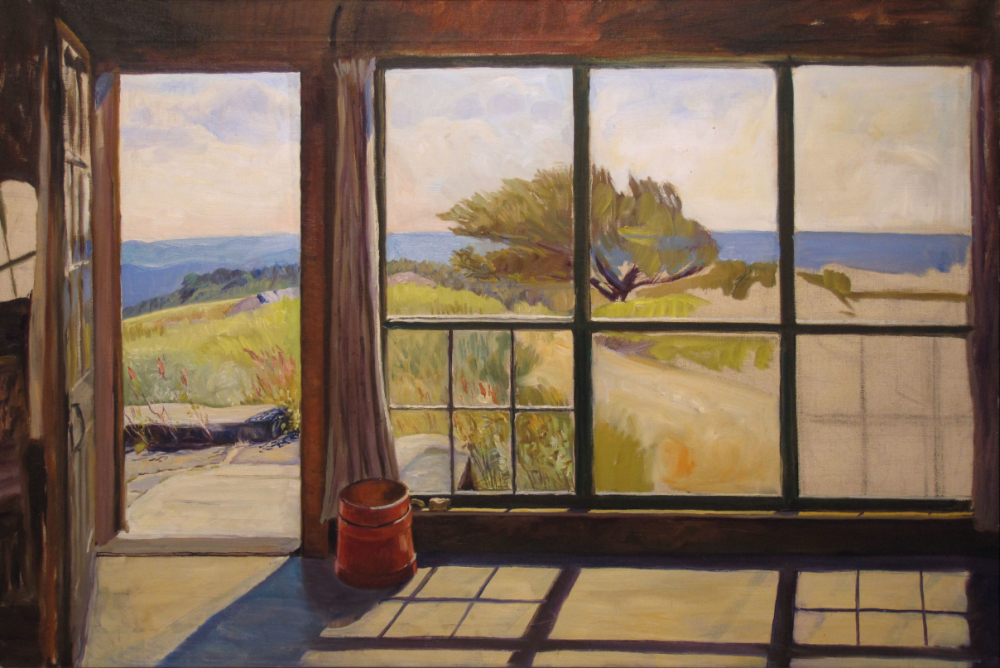
Unnamed, unfinished oil painting from Heath Studio.
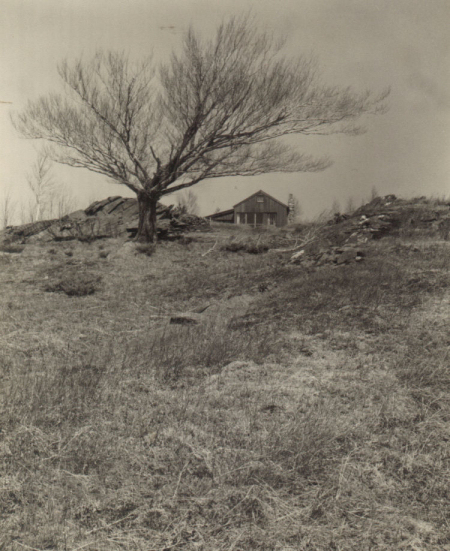
Heath pasture looking up towards beech tree and the studio.
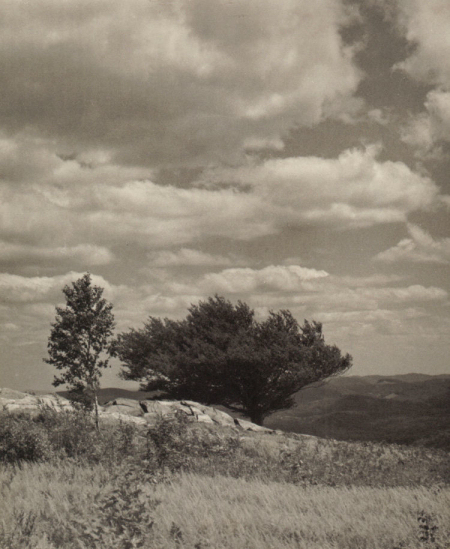
The beech tree and rock ledge with a 'sea of hills' in the distance.
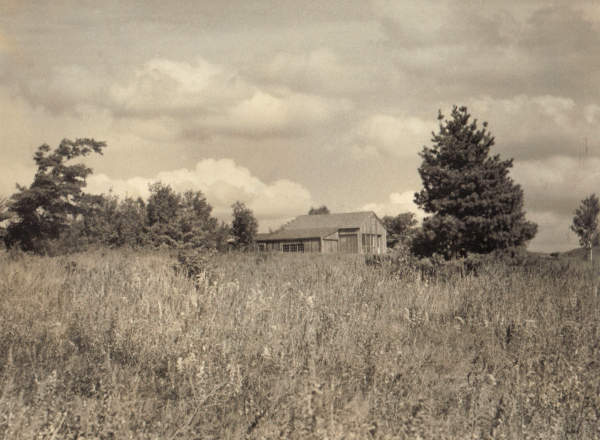
The overgrown field of blueberries and grass soon after the construction of the Pasture Studio.
The hilltop was regularly burned to eliminate weeds and brush and to encourage
blueberry growth. The stone chimney had not yet been built by Fabian.
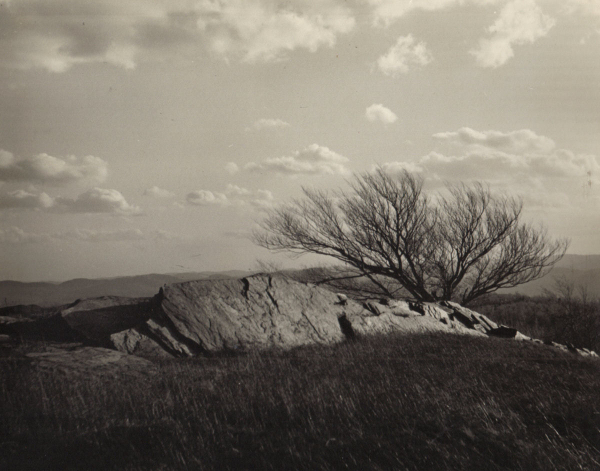
The protruding rock ledge and the beech tree.
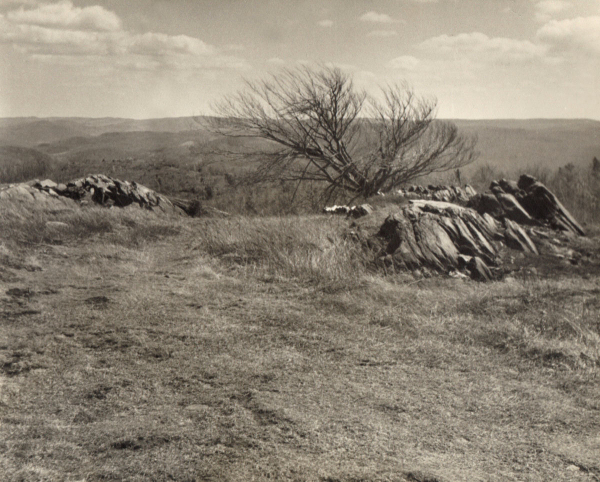
The beech tree showing signs of winter ice storm damage.
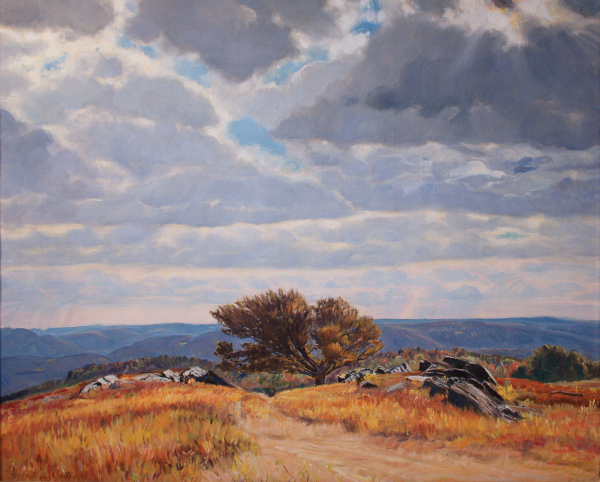
The oil painting Heath Horizon.
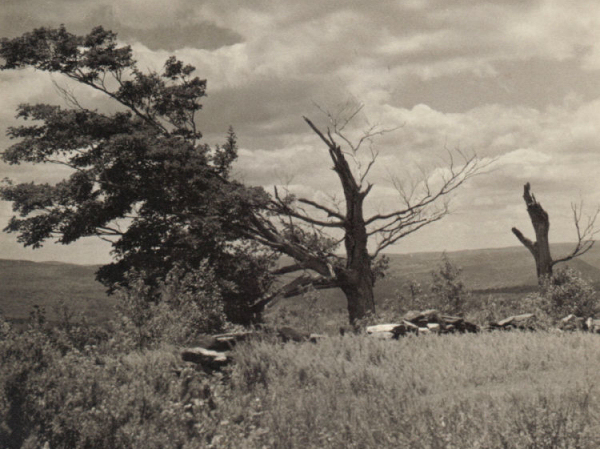
These are two trees on the Heath hilltop that RSW chose for the chalk drawing Double Victory.
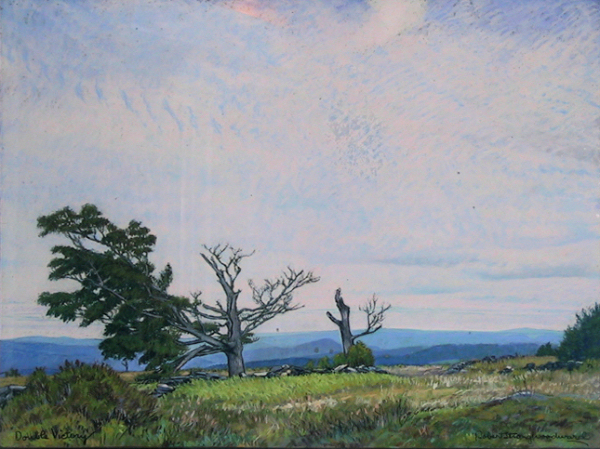
The chalk drawing Double Victory.
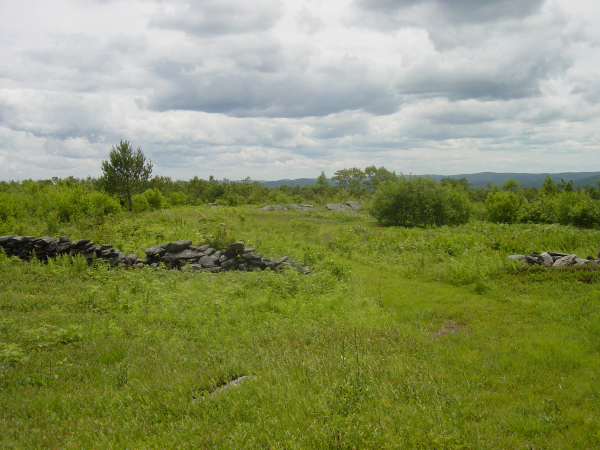
Stone wall on Burnt Hill
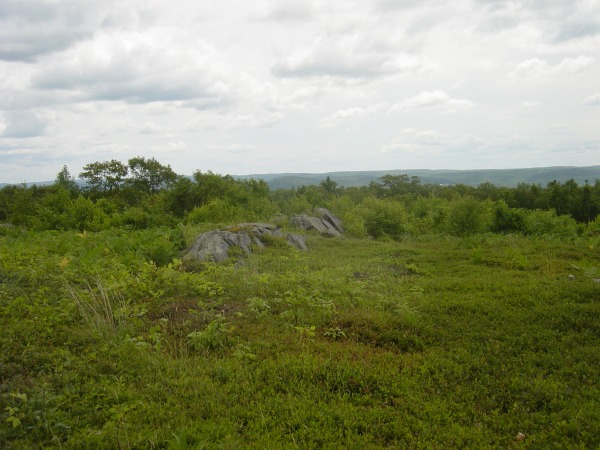
The stone bedrock outcrop on Burnt Hill.
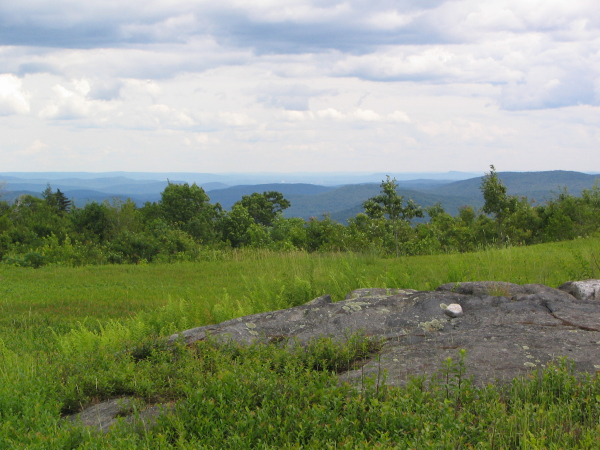
The view from Burnt Hill.
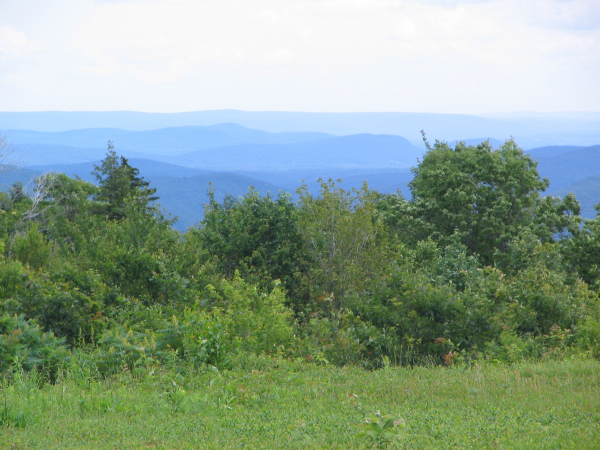
Sea of Hills seen from Burnt Hill.


